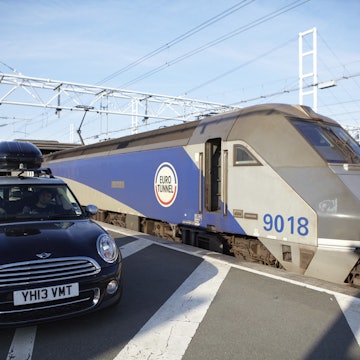

A train crossing the Knaresborough Viaduct in Yorkshire. chrisdorney/Getty Images
England’s rail network crisscrosses the country like a well-worn jumper. In just a day, you could be sipping tea by the Thames in London, wandering the medieval streets of York, and still make it to Edinburgh in time for a dram of whisky.
But it’s not just about getting from A to B in record time. Some of England’s most beloved train journeys are meant to be savored, whether you’re gliding through the rolling hills of The Cotswolds or tracing the dramatic coastline of Devon and Cornwall. Plus, with flexible tickets and rail passes, traveling by train can be a lot more budget-friendly than you might think.
With thousands of daily departures and stations even in the most remote villages, traveling by train is refreshingly simple. Spacious seats, snack trolleys serving tea and biscuits, and a front-row view of England’s stunning countryside. What’s not to enjoy?
National Rail runs most services
The backbone of England’s train system is National Rail, which brings together 27 operators running high-speed, regional and commuter trains. High-speed routes, like those operated by LNER and Avanti West Coast, link London with major cities like Manchester, Birmingham and Edinburgh in a matter of hours. Regional networks, including Great Western Railway and Northern Rail, cover smaller towns, while commuter lines like Southern and Thameslink connect suburbs to urban centers. While the system is extensive, some rural areas have fewer connections.
Train reliability in England is generally good, but delays happen due to congestion and occasional strikes, especially on busy intercity routes. The quality of trains varies. High-speed services are modern, with Wi-Fi and power outlets, while some regional trains can feel outdated.
Major stations like London Paddington and Manchester Piccadilly have great facilities, including cafes, lounges and luggage storage. In London, the Tube is the quickest way to get around, while the Overground train lines link outer neighborhoods. Overall, England’s rail system is a convenient, if sometimes unpredictable, way to travel.

Book tickets eight to 10 weeks out for the best price
Train travel in England is more expensive than in other European countries, and the cost really depends on the route, type of service and when you book. High-speed trains like LNER and Avanti West Coast will cost more than regional ones.
Unlike some countries where early booking guarantees the best price, England’s system is a bit different. The priciest Anytime and Off-Peak tickets are released up to 12 weeks in advance, while cheaper Advance fares don’t appear until eight to 10 weeks before departure. For example, London to Manchester with Avanti West Coast can cost anywhere from £32 for an Advance fare on a set departure date and time to £184 for an Anytime ticket (which is flexible). You can book tickets online through National Rail, Trainline (which does add a booking fee), or directly with individual train operators. You can even set up price alerts and choose your seat. First class is nice if you want extra space, but it’s only worth the splurge on busy or long journeys. First-class carriages also tend to be quieter.
If you’re after a sleeper train like the Caledonian Sleeper, it’s best to book early, as cabins fill up fast.
The Railcard and BritRail Pass will cut costs
If you're a student, senior or part of a group, England’s Railcards are a great way to cut down on travel costs and are available to non-residents as well. For just £30 a year, you can get 34% off Anytime, Off-Peak and Advance fares. Railcards are available for 16-25-year-olds, seniors over 60, families, veterans and those with disabilities. For example, a ticket from London to York off-peak would cost £69, but with a Railcard, it’s only £44.85 – saving you £24.15. You can buy a card online with proof of eligibility, like a student ID or age. Check out the Railcard website for more info.
If you plan to visit multiple cities, consider a BritRail Pass. It offers unlimited travel across England, Scotland and Wales for a set number of days within a specific period. You can pick between the Consecutive Day or Flexible Pass, with prices starting from £126 for a 3-day Standard Class option. The pass is only available to travelers from outside the UK, and proof of overseas residence is required when buying.
Another option to consider is the Eurail Global Pass. It covers train and ferry travel across multiple European countries, including the UK. Visit the Eurail website to find the pass that works best for your trip.

Express trains leaving London are always crowded
Trains in and out of London are always busy, especially during rush hour (6am to 8am and 5pm to 7:30pm). The 7:33am commuter service from Bedford (north of London) to Three Bridges (in West Sussex) is the country’s busiest route, according to the Department of Transport as it passes through spots like Luton and Gatwick airports as well as London. Any direct service from London Euston to major cities like Manchester will be very busy too.
As for scenic train routes, they are usually quieter than the busy commuter trains, but it’s still smart to plan ahead, as most of these routes require seat reservations. Traveling during the week or outside peak times will help you avoid crowds.
Trains are generally better than driving between cities
When comparing train travel to renting a car in England, both have their perks depending on your plans. Trains are super convenient and usually quicker than driving for getting between major cities and popular spots like the Cotswolds or the Lake District, where you can easily rent a car once you arrive to explore more remote areas.
The train is also great for getting to cities like Bath and Cardiff, with trains running regularly from London. On arrival you are then well connected to other transport like buses and to airports.
Cost-wise, trains will come out cheaper than car hire, especially if traveling solo, although you do need to book in advance, or use railcards or passes to avoid paying exorbitant last-minute train prices.
Renting a car gives you more flexibility, making it the better choice for exploring remote areas at your own pace. That said, costs can add up quickly with rental fees, fuel and parking – especially in busy tourist spots. If you're sticking to city-to-city travel, trains are usually the more affordable and hassle-free option.
Expect decent food and good legroom on board
Not all trains in England have dining onboard, but the ones that do have decent options, especially in first class. LNER’s first-class passengers get a complimentary menu with locally sourced products, like whisky from Perthshire and bread rolls from Shipley. In standard class, you can grab a meal deal, like a sandwich, drink and snack for around £6.
Longer train journeys generally mean more comfortable seating, decent legroom, semi-reliable WiFi and (mostly) clean restrooms – though train toilets are never glamorous. At least every seat has a charging port. On shorter services, like Thameslink, there’s no food or drink service, but some offer free WiFi. If you’re on a quick journey, it’s best to grab a snack before you board. Most train stations have a mini supermarket to pick up snacks and pre-made sandwiches.

England’s 5 best scenic train routes
Settle to Carlisle Railway
Few train journeys capture England’s wild beauty like the Settle to Carlisle Railway. This route carves through the Yorkshire Dales and North Pennines, passing through 14 tunnels and soaring over 20 viaducts, including the legendary Ribblehead Viaduct, a masterpiece of Victorian engineering. Expect a backdrop of rolling hills, sweeping moorlands and deep, misty valleys. Hikers, take note: this line drops you near some of England’s most rewarding walking trails.
Riviera Line
If the Devon coast has been on your radar, this train from Exeter to Paignton is one of the best ways to see it. The tracks run right alongside the sea, passing through classic seaside spots like Dawlish and Torquay. It’s one of the most beautiful short train journeys in the country.
Caledonian Sleeper Highlander
A sleeper train might not seem like the best way to take in the scenery, but the Caledonian Sleeper Highlander route from London to Fort William proves otherwise. While most of the journey through England happens under the cover of night, early risers are greeted with a dramatic Scottish landscape of heather-clad hills, rugged peaks and misty lochs. By 10am, you’ll arrive at Fort William, the gateway to some of the UK’s best outdoor adventures.

Gloucestershire Warwickshire Steam Railway
For a taste of England’s steam train history, hop aboard the Gloucestershire Warwickshire Steam Railway. You’ll roll through scenic Cotswold landscapes, and there’s always something special on board – like a gin tasting or a murder mystery event. The route is a 28-mile round trip, starting from the spa town of Cheltenham, or you can purchase one-way tickets and plan a stay at any of the stops along the route.
The Britannic Explorer: England and Wales
If you’ve ever dreamed of a luxury train journey, the British Pullman is a classic, but this year, there’s a new contender – the Britannic Explorer. Leaving from London, this luxury sleeper train offers three-night trips with routes through Cornwall, the Lake District and Wales. The Wales route is particularly special, winding through Snowdonia’s magical landscapes and the Pembrokeshire coast. Onboard, you’ll find stylish sleeper cabins, a bar with botanical cocktails and multi-course menus. Off the train, expect to picnic in a lavender field or hike through a valley.
Accessibility assistance
Most train stations in England have lifts, step-free access and accessible toilets, though smaller stations are less accommodating. You can turn up and travel without pre-booking assistance, but it’s always best to plan ahead. Onboard, many trains offer priority seating, wheelchair spaces and accessible toilets. For visually or hearing-impaired travelers, stations often have induction loops and clear announcements.
Assistance dogs are welcome, with some trains offering an Assistance Dog Under Seat card to reserve space. All train companies accept the Sunflower Lanyard for passengers with non-visible disabilities who may need extra support. For more information, visit National Rail’s accessibility page.
















